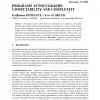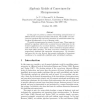492 search results - page 7 / 99 » Simplifying Probabilistic Programs Using Computer Algebra |
ICC
2008
IEEE
15 years 6 months ago
2008
IEEE
Abstract ⎯ Currently, the most advanced framework for stochastic network calculus is the min-plus algebra, providing bounds for the end-to-end delay in networks. The bounds calcu...
WSC
2000
15 years 1 months ago
2000
Input modeling that involves fitting standard univariate parametric probability distributions is typically performed using an input modeling package. These packages typically fit ...
CORR
2007
Springer
15 years 7 days ago
2007
Springer
Abstract – This study presents Albert Burroni’s polygraphs as an algebraic and graphical description of first-order functional programs, where functions can have many outputs....
196
click to vote
ICLP
2009
Springer
16 years 27 days ago
2009
Springer
Probabilistic logic programs (PLPs) define a set of probability distribution functions (PDFs) over the set of all Herbrand interpretations of the underlying logical language. When...
118
Voted
FAC
2000
15 years 2 days ago
2000
In this paper we present a method of describing microprocessors at different levels of temporal and data abstraction. We consider microprogrammed, pipelined and superscalar proces...


